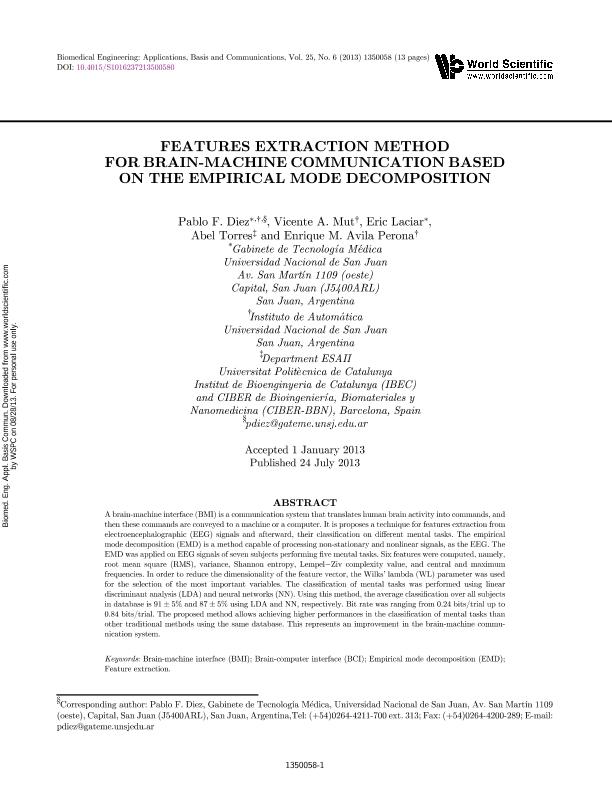Mostrar el registro sencillo del ítem
dc.contributor.author
Diez, Pablo Federico

dc.contributor.author
Mut, Vicente Antonio

dc.contributor.author
Laciar Leber, Eric

dc.contributor.author
Torres, Abel
dc.contributor.author
Avila Perona, Enrique Mario

dc.date.available
2017-10-17T15:36:20Z
dc.date.issued
2013-07
dc.identifier.citation
Diez, Pablo Federico; Mut, Vicente Antonio; Laciar Leber, Eric; Torres, Abel; Avila Perona, Enrique Mario; Features extraction method for brain-machine communication based on the empirical mode decomposition; World Scientific; Biomedical Engineering-applications Basis Communications; 25; 6; 7-2013; 1-13
dc.identifier.issn
1016-2372
dc.identifier.uri
http://hdl.handle.net/11336/26707
dc.description.abstract
A brain-machine interface (BMI) is a communication system that translates human brain activity into commands, and then these commands are conveyed to a machine or a computer. It is proposes a technique for features extraction from electroencephalographic (EEG) signals and afterward, their classification on different mental tasks. The empirical mode decomposition (EMD) is a method capable of processing non-stationary and nonlinear signals, as the EEG. The EMD was applied on EEG signals of seven subjects performing five mental tasks. Six features were computed, namely, root mean square (RMS), variance, Shannon entropy, Lempel-Ziv complexity value, and central and maximum frequencies. In order to reduce the dimensionality of the feature vector, the Wilks´ lambda (WL) parameter was used for the selection of the most important variables. The classification of mental tasks was performed using linear discriminant analysis (LDA) and neural networks (NN). Using this method, the average classification over all subjects in database is 91 ± 5% and 87 ± 5% using LDA and NN, respectively. Bit rate was ranging from 0.24 bits/trial up to 0.84 bits/trial. The proposed method allows achieving higher performances in the classification of mental tasks than other traditional methods using the same database. This represents an improvement in the brain-machine communication system.
dc.format
application/pdf
dc.language.iso
eng
dc.publisher
World Scientific

dc.rights
info:eu-repo/semantics/openAccess
dc.rights.uri
https://creativecommons.org/licenses/by-nc-sa/2.5/ar/
dc.subject
Brain-Machine Interface (Bmi)
dc.subject
Brain-Computer Interface (Bci)
dc.subject
Empirical Mode Decomposition (Emd)
dc.subject
Feature Extraction
dc.title
Features extraction method for brain-machine communication based on the empirical mode decomposition
dc.type
info:eu-repo/semantics/article
dc.type
info:ar-repo/semantics/artículo
dc.type
info:eu-repo/semantics/publishedVersion
dc.date.updated
2017-10-12T21:22:54Z
dc.identifier.eissn
1793-7132
dc.journal.volume
25
dc.journal.number
6
dc.journal.pagination
1-13
dc.journal.pais
Singapur

dc.description.fil
Fil: Diez, Pablo Federico. Universidad Nacional de San Juan. Facultad de Ingeniería. Departamento de Electrónica y Automática. Gabinete de Tecnología Médica; Argentina. Consejo Nacional de Investigaciones Científicas y Técnicas; Argentina
dc.description.fil
Fil: Mut, Vicente Antonio. Universidad Nacional de San Juan. Facultad de Ingeniería. Instituto de Automática; Argentina. Consejo Nacional de Investigaciones Científicas y Técnicas; Argentina
dc.description.fil
Fil: Laciar Leber, Eric. Universidad Nacional de San Juan. Facultad de Ingeniería. Departamento de Electrónica y Automática. Gabinete de Tecnología Médica; Argentina. Consejo Nacional de Investigaciones Científicas y Técnicas; Argentina
dc.description.fil
Fil: Torres, Abel. Universidad Politécnica de Catalunya. Departamento de Ing.de Sistemas, Automat.e Inf.industrial; España
dc.description.fil
Fil: Avila Perona, Enrique Mario. Universidad Nacional de San Juan. Facultad de Ingeniería. Instituto de Automática; Argentina
dc.journal.title
Biomedical Engineering-applications Basis Communications

dc.relation.alternativeid
info:eu-repo/semantics/altIdentifier/url/http://www.worldscientific.com/doi/abs/10.4015/S1016237213500580
dc.relation.alternativeid
info:eu-repo/semantics/altIdentifier/doi/http://dx.doi.org/10.1142/S1016237213500580
Archivos asociados
